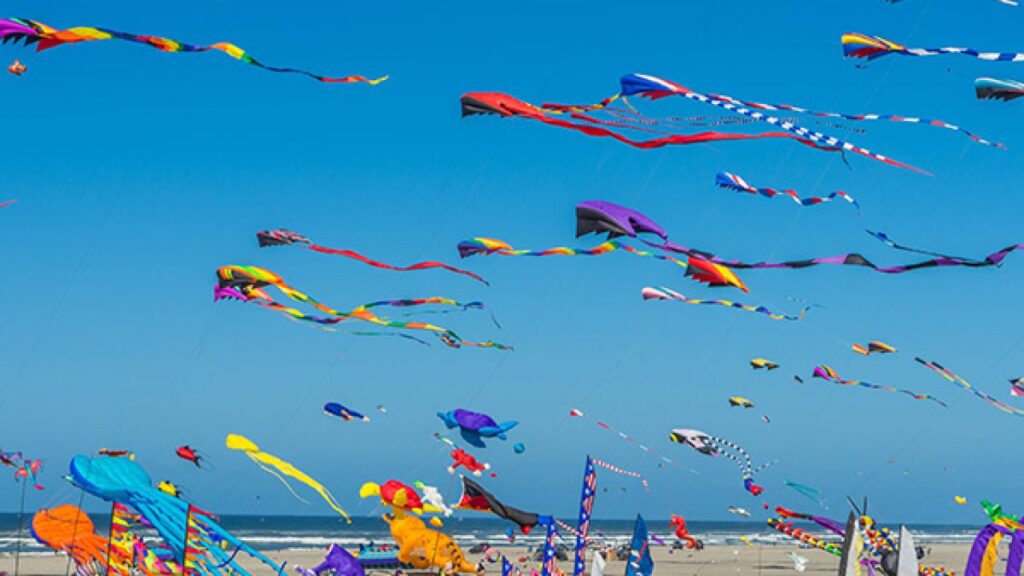
Gujarat observes more than 200 festivals annually. The International Kite Festival, also known as Uttarayan, is one of the most important holidays. Homes in Gujarat start producing kites for the celebration months in advance.
According to the Indian calendar, the festival of Uttarayan commemorates the day when winter officially transitions into summer. For farmers, it is a sign that the sun has returned and that Makara Sankranti/Mahasankranti. The harvest season, is quickly coming. Given that it signals the end of winter and the start of the harvest season. This is one of the most significant harvest days in India. Gujarat has many cities that host kite contests for its residents.
Uttarayan is such a significant event in this area of Gujarat and many other states that it has been declared a two-day national holiday in India. Local dishes like undhiyu (a mixed vegetable dish with yam and beans), chikki (sesame seed brittle), and jalebi are offered to the masses during the event. A few days before the event, participants are buying all of their goods at the market.
Due to the involvement of 42 nations that year, the International Kite Festival in Gujarat was striving to break the Guinness World Records, according to the Tourism Corporation of Gujarat.
Dates Of International Kite Festival
Every year, on January 14, during Makar Sankranti, the event begins and lasts till January 15. For farmers in the Gujarat area, this day signifies the end of winter and the beginning of more pleasant weather. To ensure that everyone may take part in the festivities, these days have also been declared a public holiday in the Indian state of Gujarat. Vasi Uttarayan is celebrated on January 15.
Location For International Kite Festival
Numerous towns in Gujarat, Telangana, and Rajasthan, including Ahmedabad, Jaipur, Udaipur, Jodhpur, Surat, Vadodara, Rajkot, Hyderabad, Nadiad, and Dakor, celebrate the International Kite Festival, also known as Uttarayan. The worldwide kite festival, nevertheless, is held in Ahmedabad, Gujarat’s kite capital, which welcomes people from many other countries.
The Sabarmati Riverfront (which can accommodate over 500,000 people on its Sabarmati river bank) or the Ahmedabad Police Stadium, where people lie down to watch the sky filled with hundreds of kites, are the ideal places to enjoy this celebration.
The marketplaces are crowded with kite buyers and sellers throughout the festival week. One of the most well-known kite marketplaces, Patang Bazaar, is located in the centre of Ahmedabad. During the festival week, it is open 24 hours a day, with buyers and sellers haggling and purchasing in large quantities.
In Ahmadabad, many households start constructing kites at home and open small businesses there.
A kite museum may be seen in Sanskar Kendra in Ahmedabad’s Paldi neighbourhood. It was founded in 1985 and has a variety of unusual kites.
The kite festival is also observed in other regions of India, including Delhi on August 15 and the majority of Bihar’s districts on April 14. People pray and eat sattu (a dish prepared from freshly harvested wheat) and new mangoes (baby mango, also known as Tikola).
History
This celebration serves as a metaphor for the gods emerging after a long slumber. It is said that kite flying originated in India thanks to the country’s monarchs and royals, who were later followed by nawabs who enjoyed the activity and used it to demonstrate their strength and expertise. As the sport gained popularity throughout time, it started to appeal to a wider audience. In Gujarat, kite flying has long been a popular pastime. However, the first international festival was held in 1989, when participants from all over the world displayed their creative kites.
In 2012, Chief Minister Narendra Modi officially opened the International Kite Festival in front of Governor Kamla Beniwal.
Participants
The Rigveda, which is almost 5000 years old, makes reference to this celebration. The fortunate six-month period known as Uttarayana begins on this day. No of a person’s origin or beliefs, they are now allowed to fly kites in Gujarat in January with the rest of the population. The majority of visitors come from other states or Gujarat itself in India. Kite flying begins as early as five in the morning and lasts till late at night in Gujarat’s largest cities. A whopping 8–10 million people attend the festival.
To celebrate, however, a large number of people travel from all over the world, including Japan, Italy, the UK, Canada, Brazil, Indonesia, Australia, the US, Malaysia, Singapore, France, and China.
Recent events have had a big impact on the festival thanks to its worldwide attendees, like:
- Malaysian wau-balang kites were imported.
- Llayang-llayanghave was imported from Indonesia.
- The US sent enormous kites for banners.
- Rokkaku battle kites originated in Japan.
- Italian sculpture kites were brought over.
- Chinese visitors brought flying dragon kites.
- See the list of Kite types for further kites.
Numerous prominent figures, including well-known dancers, singers, actors, celebrities, or politicians, come during this event to delight the crowd. For instance, the Bollywood actress Juhi Chawla participated in the event in 2004 and danced the garba, a dance that is highly well-liked in India. [16]
Variety of Kites
Along with food booths and entertainment, kite markets are set up during the event. The ones for Uttarayan are constructed of lightweight paper and bamboo, and are often rhombus-shaped with a central spine and a single bow. Typically, they are produced with materials like plastic, leaves, wood, metal, nylon, and other discarded materials. The kite is also painted and dyed to add to its glitz. The lines are coated with glue and crushed glass combinations known as firkees, which dry, roll up, and connect to the back and become sharp enough to cut skin. In kite fighting competitions, these kinds of razor-sharp lines are attached to fighter kites, also known as patangs in India.
Tukals, also known as lit kites with lights and candles, are released on the second night of the celebration, creating a display in the night sky.
If you want to know about National Kid Inventor’s Day Then Click HERE

